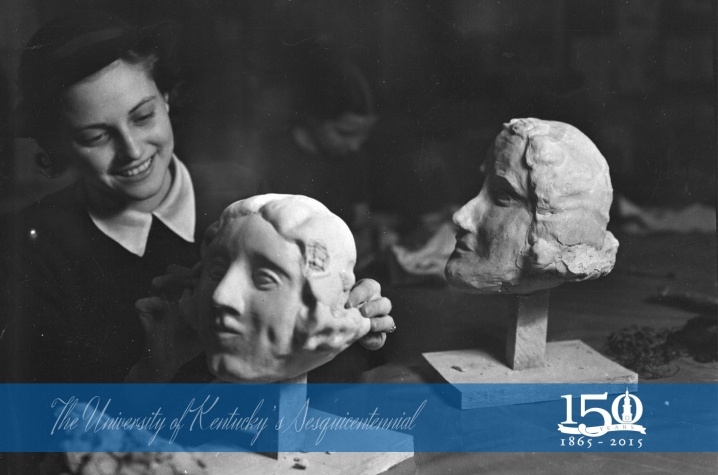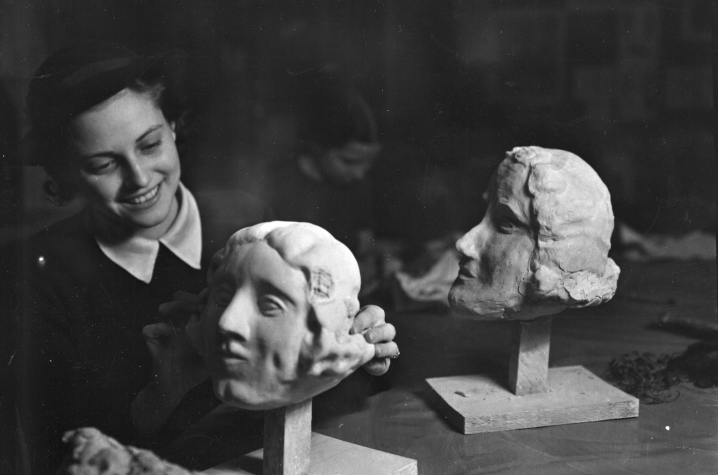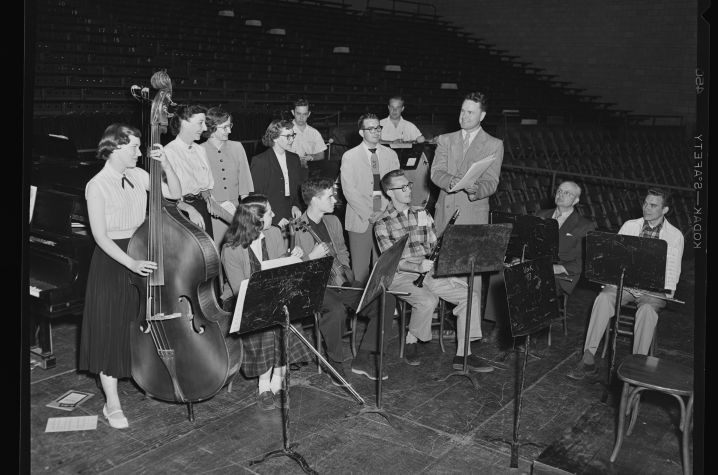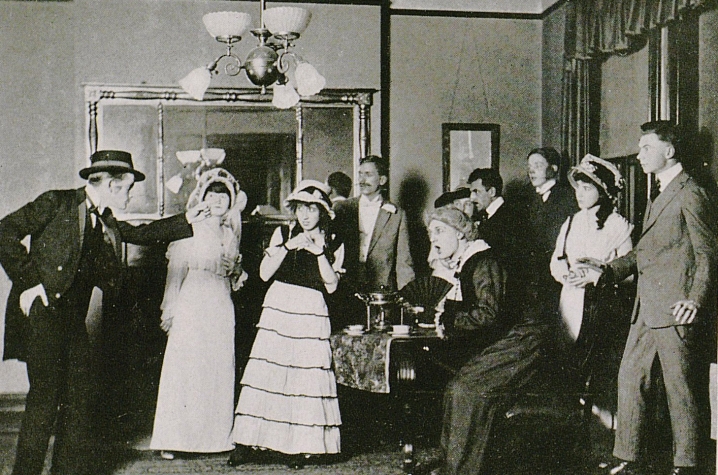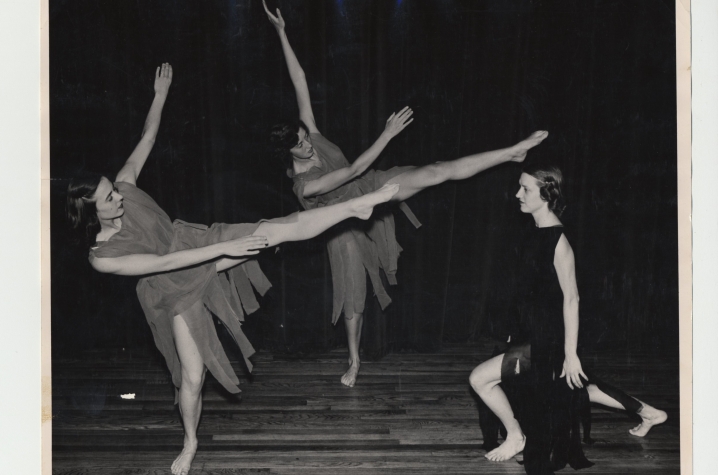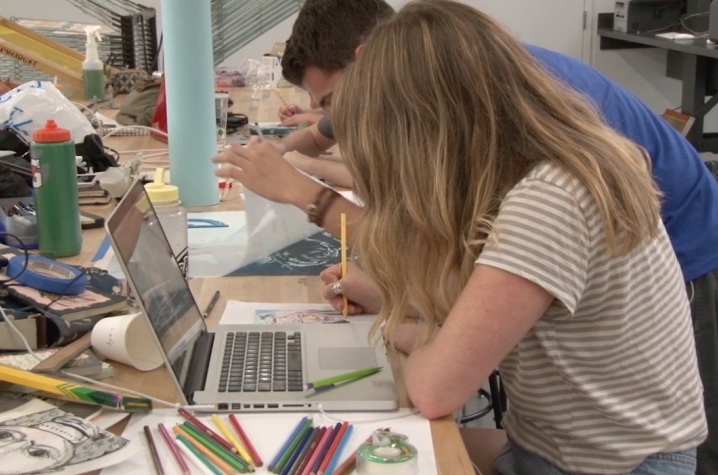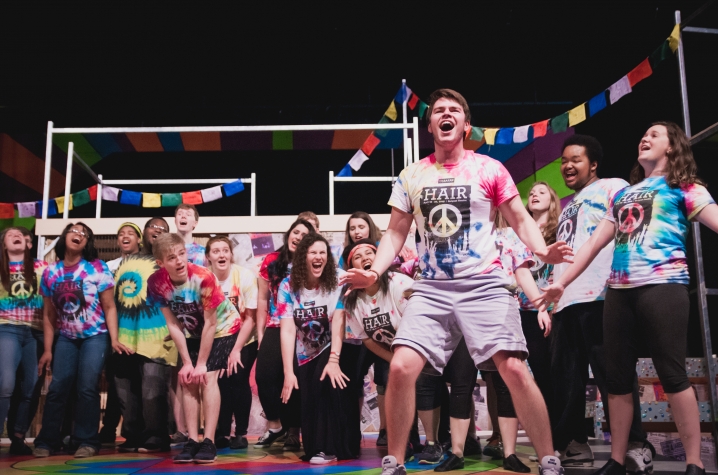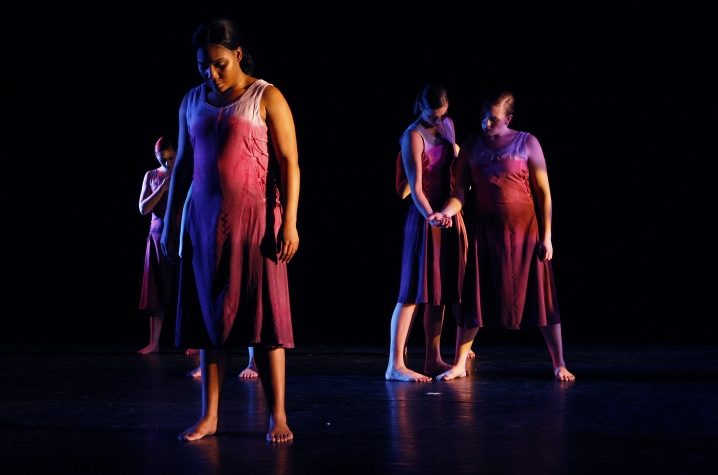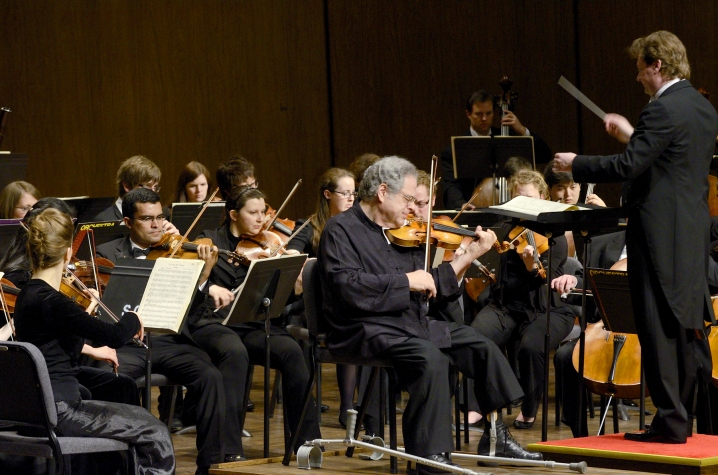UK College of Fine Arts: Shining a Spotlight on Creative Education, Performance and Research
LEXINGTON, Ky. (Nov. 30, 2015) — Though the University of Kentucky College of Fine Arts is the second youngest college on campus, the arts took the stage at the university not long after it was founded in 1865 with the formation of the College of Science, Literature, and Art (now the College of Arts and Sciences). Embracing the concept that the arts are essential to the life of the individual and the community, the UK College of Fine Arts expresses this today through a dedication to teaching, scholarly research, artistic experimentation, performance, and exhibition.
Though art was part of one of the first college's names, the institution’s first classes in art, drama and music were offered in 1881. By the early 1900s, performance groups began to debut on campus with a Kentucky State College Glee Club in 1902 and Captain George L. Byroade's military band in 1903, precursors to today's seven celebrated choral ensembles and the 250 strong Wildcat Marching Band. By 1910, the Strollers Dramatic Society took drama from the classroom to the stage with their first production of "Richelieu," by Edward Bulwer-Lytton.
It would be a few more years before the university's art students' work would join the school's other talents in the spotlight. A year after President Frank McVey formed the Department of Art and Music, the president proposed the school's first art exhibition in 1919.
In 1922, the first of several facilities was dedicated to the arts with the purchase of a former African American Consolidated Baptist Church and supplementary structures on Winslow and Euclid, which would become home to Romany Theatre, under the direction of UK's Department of English. The Art Department moved in three years later. This center was then enlarged with two more buildings to house the Departments of Drama and Music in 1927. A year later, the Romany would take a new name, Guignol. While the original theatre was lost to fire in 1947, UK's theatre and dance students still perform at the Guignol Theatre in the Fine Arts Building on Rose Street today. In 1929, UK created its first museum dedicated to art.
The 1930s and 40s saw the university arts programs offering in-service training to music teachers, the first European tour for students, the earning of accreditation from the National Association of Schools of Music, the first graduate degrees in music conferred and the first bachelor's degree in art education.
In 1950, the Fine Arts Building opened on central campus. The new building was home to the music, theatre and visual arts departments and a new Guignol Theatre, which staged "Medea" as its first production with future arts patron Lucille Little in the lead role.
With the continued growth of the arts on campus, more space was needed for the visual arts programs and the Reynolds Building, a former tobacco warehouse, was used to house the overflow beginning in 1965. The next year, UK College of Arts and Sciences grouped the arts programs into the School of Fine Arts and named Hubert Henderson its director. By 1967, the Department of Theatre (now the Department of Theatre and Dance) was approved. The late '60s-early '70s also saw the creation of several more degrees including doctoral degrees in music teaching and musicology and the MFA (Master of Fine Arts) degree, as well as a name change for the music department to the UK School of Music (as it is known today).
In the 1970s, the arts programs took center stage at UK with the formation of a college dedicated to music, theatre and the visual arts in 1976, first led by acting dean Herb Drennon. In 1978, J. Robert Willis took over the dean's position and the Department of Art began offering a BFA. A year later, UK dedicated a Center for the Arts at the corner of Rose and Euclid, which would be renamed for President Otis A. Singletary in 1986.
In the 1980s, the College of Fine Arts embarked on a new area of study and created the Arts Administration Program, one of the first in the nation. The new program, approved in 1988, educates students on the business side of the arts in the management of arts organizations. The decade also sees the opening of a laboratory theatre, the Wallace N. Briggs Theatre, named for an alumnus who operated the Guignol for years. Briggs Theatre was created as not only a second performance space but also a working classroom space for theatre students.
To aid in the education and research experience, UK Friends of Music was established in 1991 to raise money for students and faculty travel needs. Similarly, the College of Fine Arts Dean's Circle was created to help support the mission of students and faculty across the college in 1996. The decade also saw the expansion of services offered outside the college with the development of the UK Fine Arts Institute, which offers noncredit community education courses in the visual arts three times a year, and the establishment of UK Opera Theatre and the John Jacob Niles Center for American Music, as well as the college's first endowed chair position, held by celebrated opera singer Gail Robinson.
Since 2000, UK College of Fine Arts' celebrated student artists and faculty in opera, choral music, orchestra, jazz, percussion, brass, wind, theatre and the visual arts have routinely earned opportunities to demonstrate their talents on national and even international stages. In addition, college faculty has had great success with research in all areas from studies in ethnomusicology and art history to innovative new techniques in art, dance, music and theatre production. This acclaim continues to spur growth in the college. A digital lab and the Lucille C. Little Fine Arts Library and Learning Center opened in 2000. The library became not only a valuable resource for fine arts students and faculty but also one of the favorite study spaces on campus for the entire student body. In 2004, the college joined forces with UK College of Agriculture, Food and Environment to place arts advocates in communities across the state with the creation of nation's first fine arts extension agent in Pikeville, Kentucky. Two years later, the college opened its first living learning (LLP) community on campus in what is now Roselle Hall, where students with similar interests in the arts can live, study and rehearse together. With the support of William E. And Casiana Schmidt, the Schmidt Vocal Arts Center opened in 2009.
It was this growth and talent that attracted Michael Tick to the dean's position in 2010. "I conducted a tremendous amount of research on UK, especially the College of Fine Arts. It didn’t take me long to realize that most of the faculty had national and international reputations in their field. Frankly, I could think of nothing better than having the privilege of serving as dean of an outstanding college that consistently achieved excellence. During the interview process, I also had the opportunity to meet many students, majors and nonmajors. Their intellectual curiosity, talent and deep-seated love for UK especially impressed me."
The College of Fine Arts has continued to grow and prosper in recent years. The college reinstituted a dance minor in the UK Department of Theatre and Dance in 2011. That same year, UK School of Music teamed up with UK HealthCare to offer the state's first master's degree in music therapy.
In 2012, the college created the first totally online master's program in arts administration at a public university, changed the Department of Art's name to the UK School of Art and Visual Studies recognizing further growth in the visual arts programs, and welcomed the UK Art Museum to the college. The year also marked the purchase of a new facility for the art studio and art education students. The following year, UK School of Music and UK Department of Theatre and Dance teamed up to create a musical theatre certificate program.
This fall, UK School of Art and Visual Studies opened its new state-of-the-art academic creative space on Bolivar Street. The Art and Visual Studies Building is not only home to artist studios and instructional spaces, but also features five digital media labs and a 3D fabrication lab, as well as a gallery for student and faculty shows and special exhibitions. The college also received a substantial gift from businesswoman Ann Bakhaus and her family, which will fund a recurring annual budget for productions for UK Opera Theatre, based on a donation of property to WUKY. The gift will also make a high-tech recording space available to students and programs in UK School of Music.
UK School of Art and Visual Studies from University of Kentucky on Vimeo. Video by Jenny Wells, UK Public Relations and Marketing.
Today, the college offers Kentucky's most comprehensive array of educational programs devoted to the visual and performing arts. Degrees offered include bachelor's and master's degrees in studio art, art education and art history and visual studies; bachelor's and master's degrees in arts administration; doctoral (both DMA and PhD), bachelor's and master's degrees in music; and a bachelor's degree in theatre. In addition, students can minor in art history, art studio, digital media and design, photography, dance, music performance, music theory and history, theatre, and visual studies.
With around 400 productions a year, the Singletary Center for the Arts, the college’s performing arts facility, supports the School of Music and presents national and international artists and speakers to facilitate the college's mission of providing artistic and cultural experiences for the education and benefit of students, the university, and the Commonwealth.
The college is also home to UK Art Museum. Located in the Singletary Center, the museum is Central Kentucky's premier accredited art museum with a collection of more than 4,800 objects. The museum reaches more than 10,000 students and teachers annually throughout Kentucky.
Happy with the success the college has recently enjoyed, Dean Tick is even more excited about the future. "The College of Fine Arts is in a period of unprecedented vitality and accomplishment as evidenced in so many varied ways: enrollment and academic/artistic growth, renovated and new facilities, and increased philanthropy. Although the SA/VS Art Building is magical, I can hardly wait to open the new Creative Arts LLP in fall 2016."
The proposed Creative Arts LLP in the Limestone Park I residential hall will contain an immersion performance studio with visualization capability for art, music, dance and film/video; solo and ensemble practice rooms; an art studio; and a writing lab.
Tick also hopes to see the music therapy program expand in the coming years. "The growth of our music therapy program deserves special recognition for its huge impact on patient care and satisfaction. I look forward to working with UK HealthCare on introducing a Ph.D. in music therapy and perhaps, adding other therapies such as visual art and dance."
Plans are in place for the School of Music to design its first band hall in the coming years, to be located behind the Schmidt Vocal Arts Center.
Changes like these are music to Tick's ears, and he has ideas to build an even better college given the opportunity. "Nothing would be more special than to renovate and expand the Fine Arts Building and the Singletary Center. We would also build a new Art Museum in partnership with the city. Did I also say that we’d like to build a theatrical roadhouse on the corner of Avenue of Champions and Rose Street?"
Now that's a showstopper.
MEDIA CONTACT: Whitney Hale, 859-257-8716; whitney.hale@uky.edu





